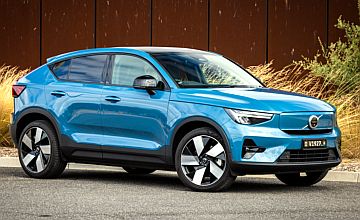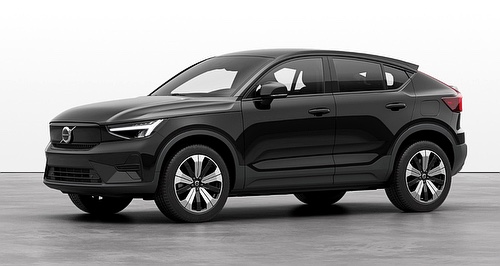Make / Model Search
OptionsCar reviews - Volvo - C40 - RechargeVolvo modelsOverviewWe like Cohesive styling, subscription and after-sales support, rapid acceleration, accurate steering, logical HMI, surprisingly spacious and practical cabin Room for improvement Firmer ride and suspension noise, poor rearward vision, no cover for glass ceiling, range claims impossible to achieve, EV charging infrastructure We spend a month with Volvo’s all-electric C40 to see if the EV dream matches reality6 Mar 2023 By MATT BROGAN Overview
THE Volvo C40 Recharge Pure Electric arrived in Australian showrooms late last year priced from $74,990 plus on-road costs in single-motor guise. Among others, it is a rival to Mercedes-Benz EQA (from $76,800 + ORC) and twin-under-the-skin Polestar 2 (from $63,900 + ORC).
The Small SUV segment EV – which is offered in single- and twin-motor format – rides on Volvo’s Compact Modular Architecture (CMA) platform shared with the closely related Polestar 2 and boxier, more practical Volvo XC40.
Like the Polestar, the C40 Recharge Pure Electric (RPE) presents as a sporty, coupe-like offering with five leather-free seats, a high-set driving position and an Android-based operating system that provides drivers with Google apps and built-in services, including Google Maps, Google Assistant, and Google Play Store.
Being a Volvo, the C40 RPE features an extensive list of safety equipment including forward collision warning and mitigation, front and rear park assist, blind-spot monitoring, cross-traffic alert, adaptive cruise control, lane keeping aid, parking assistance, hill start assist and hill descent control.
The model also offers keyless entry, remote-opening and electrically operated tailgate, panoramic roof, auto-dimming mirrors, dual-zone climate control, heated front- and rear seats, as well as power-folding head restraints.
Additionally, twin-motor variants (from $82,490 + ORC, as tested) receive all-wheel drive, 20-inch alloys, 360-degree camera technology, a harman/kardon premium audio system, and Microtech & Textile upholstery.
The single-motor Volvo C40 RPE outputs 170kW/330Nm and offers up to 434km of driving range while the twin-motor produces 300kW/660Nm and travels up to 420km. Respectively, the duo can accelerate from standstill to 100km/h in 7.4 and 4.7 seconds.
Battery capacity is listed at 67kWh in single-motor trim and 75kWh for the twin-motor with charging from a household outlet taking as long as 40 hours to achieve. A 150kW DC fast charger will reduce that number to as low as 32 minutes (from 10 to 80 per cent).
The small-segment SUV measures 4431mm in length, 1875mm in width and 1582mm in height and offers a cargo area of 413 litres in five-seat mode (and to window height).
Both C40 RPE variants come with Volvo's five-year / unlimited-kilometre warranty, an eight-year roadside assistance package, eight-year battery warranty and two-year interval servicing.
Driving Impressions
IT IS of critical importance that the driving experience of the Volvo C40 RPE is differentiated – even distanced – from the EV ownership experience we suffered through during our month with the vehicle; as the latter lets the former down by a long, long margin.
As enjoyable and practical as the C40 RPE is, the infrastructure relied upon to charge the vehicle is sorely lacking – and the attitude of those tasked with providing this necessary service apathetic at best.
Using the Chargefox network to keep the ergs up to the C40 RPE over the past month has been a continual disappointment. The app continually contradicts the availability of the physical network with most units out of order upon arrival.
When questioned by phone, the provider’s customer service agent offered excuses ranging from “the government” to COVID-19, parts delays, app glitches and “the machines”, as if they have a mind of their own.
Fortunately, a not-so-nearby competitor (Evie) provided a functional high-speed charger that was both simpler and cheaper to use but the experience with Chargefox did leave us questioning the practicalities of EV ownership in the here and now.
Without a 7.4kW home charger as a minimum, the ownership experience is far from ideal. Given the way the vehicle was utilised during its month with GoAuto, a fast public charger makes more sense – assuming a functional one can be found.
It is a pity the network cannot be relied upon and is currently too sparse to match the convenience of wet fuels. With a bit of luck, we’ll get there soon, and more people will get to experience cars like the C40 RPE.
On the plus side, almost every other aspect of life with the C40 RPE was convenient and enjoyable.
No more fumbling for keys and starter buttons, just approach the car, open the door, select Drive and away you go. It doesn’t get much easier. You can even operate most of the vehicle’s settings by voice, assuming the touchscreen is too difficult to comprehend (which it isn’t).
The pared back feel of the cabin and instrumentation belies just how much is going on behind the scenes.
The infotainment offerings, incredibly accurate navigation, and easy-to-use climate control systems are child’s play to anyone who can operate a smartphone – the climate control can even maintain cabin temperature while parked, which is a blessing during hot summer afternoons.
We did, however, find the climate control quite noisy at speed settings ‘2’ or above, and noted the system struggled to keep the cabin cool owing to the large area of uncovered glass on the ceiling above. It’s a point we’ve noted with the C40 and Polestar 2 before, and one that really needs to be addressed for hot climate markets like Australia.
It would also be terrific if the infotainment system would offer wireless connection for Apple CarPlay, especially given how ‘techy’ the rest of the interface is. Maybe that’s something we can look forward to in the future, eh Volvo?
The feel at the wheel of the slick-looking C40 is adaptable in two settings: firm or soft. The only other driving option is to engage one pedal mode, which some may like and others not. In our view, once you’re used to it, it is very hard to imagine living without.
Conversely, we found the suspension tune (which initially feels firm owing to the C40 RPE’s hefty 2154kg kerb weight) quite unwieldy over uneven surfaces. The car feels underdamped and tends to ‘pogo’ in certain scenarios which perhaps shows the car is tuned for roads that are far better maintained than ours.
Still, lumpy rural roads are not something most of us encounter every day, and in urban running, the C40 RPE is very sedate.
Speed humps and roundabouts are dispensed without fuss and supermarket car parks navigated easily thanks to the brilliant 360-degree camera system. It’s a very handy feature owners will no doubt come to rely on given the C40 RPE’s sleek body does hinder the view to the rear. There isn’t even a rear wiper to clear the view on a rainy day.
The ride is mostly quiet, save for a little tyre thrum and a slight whine of the front motor at freeway speeds – which we must say the dual motor version of the C40 RPE reaches very quickly indeed.
From standstill and when overtaking the Volvo leaps forward with eagerness, dashing to triple digits with absolute ease. The grip available is simply phenomenal with no wheel slip at all. The C40 RPE hussles off the line even at moderate throttle openings (I guess we can still call it that?) but is wonderfully well-metered for those times a less urgent getaway is required.
And most of the time that’s exactly how the car was driven. It serenely cruises the urban streets we use to assess loan vehicles and flits in and out of parking spaces with effortless precision. The lack of guesswork required in manoeuvring the C40 RPE in tight spaces is confidence inspiring, a good thing considering how attractive those large-diameter alloys look.
The regenerative powers of the braking system mean one-pedal mode or pressure on the brake pedal is required to put charge back into the system, the vehicle offering no paddle shifts or ‘transmission style’ braking mode like some rivals in this space. That said, we find it makes for an easier transition when moving from an ICE vehicle, and those new to the EV game will probably feel much the same way.
On the practicality front, we found the charging system easy to use, the contactless doors and tailgate incredibly handy, and the cabin stowage generous. There are plenty of places to store your odds and ends, the door pockets in particular some of the roomiest we’ve ever encountered. The fold flat rear seats and underfloor cargo area storage are also very handy, extending the capabilities of the C40 RPE’s luggage space considerably.
In true Volvo style the seating is supportive and simple to adjust. The ideal driving position is easy to obtain and set, and the driver’s relationship to the control, view of the instrument panel and forward visibility right up there. The chunky A-pillar, however, means the view when approaching a diagonal intersection or roundabout can be compromised.
So, it may sound like we had a hard time giving the Volvo back… well, almost.
You see, it was difficult, in fact, impossible to achieve the manufacturer’s range claims, even when pussyfooting the car around the ‘burbs. We achieved between 330km and 360km driving a mix of suburban (90%) and freeway (10%) over the course of four charge cycles (down to 10 per cent from empty).
Depending on which provider you use to charge the vehicle, that equates to around 18.1 cents per kilometre. We’ll let you do the maths to see how that stacks up against your current wet fuel car, but we wouldn’t mind tipping it as very close (by way of reference our petrol-powered Škoda Kodiaq Sportline that averages 17.6 cents per kilometre).
As good as it is to drive, the Volvo C40 Recharge Pure Electric is also great to look at, and a pleasure to live with (if you don’t count on public charging stations, that is). The brand’s sustainable backstory, the thoughtfulness of design and the roomy interior mean it is a very easy car to like… unless of course you look at the price tag.
See, given the C40 RPE is essentially a rebadged Polestar 2 – which can be had in near-identical specification for $9090 less – the reason for stumping up the extra coin is rather difficult to justify. We’ve driven both, and they’re remarkably similar in just about every aspect, which means you’d want to be very attached to the Iron Mark to justify your call.
But whichever way you jump, we don’t think you’ll be disappointed. Just save yourself the heartache of a visit to the Chargefox station.  Read more3rd of November 2022  Volvo to sell 20,000 BEVs annually by 2026Shift in consumer sentiment, supply surety buoy Volvo’s confidence in electric switch3rd of November 2022  Volvo to go all BEV in Oz from 2026Local importer beats head office to the all-electric punch by four full years26th of October 2022  2022 Volvo C40 Recharge Pure Electric ReviewVolvo’s second pure-electric model has arrived with up to 300kW of emissions free powerAll car reviews Alfa Romeo Alfa Romeo Abarth Abarth Alpine Alpine Alpina Alpina Audi Audi Aston Martin Aston Martin BMW BMW Bentley Bentley Chevrolet Chevrolet Chery Chery Citroen Citroen Chrysler Chrysler Dodge Dodge Cupra Cupra Ferrari Ferrari DS DS Ford Ford Fiat Fiat FPV FPV Foton Foton GWM GWM Great Wall Great Wall Holden Holden Haval Haval HSV HSV Honda Honda Hyundai Hyundai Hummer Hummer Isuzu Isuzu Infiniti Infiniti Jeep Jeep Jaguar Jaguar Lamborghini Lamborghini Kia Kia LDV LDV Land Rover Land Rover Lotus Lotus Lexus Lexus Maserati Maserati Mahindra Mahindra McLaren McLaren Mazda Mazda Mercedes-Benz Mercedes-Benz Mercedes-AMG Mercedes-AMG Mini Mini MG MG Nissan Nissan Mitsubishi Mitsubishi Peugeot Peugeot Opel Opel Proton Proton Porsche Porsche Renault Renault Ram Ram Rover Rover Rolls-Royce Rolls-Royce Skoda Skoda Saab Saab SsangYong SsangYong Smart Smart Suzuki Suzuki Subaru Subaru Toyota Toyota Tesla Tesla Volvo Volvo |
OptionsClick to share
|











Facebook Twitter Instagram